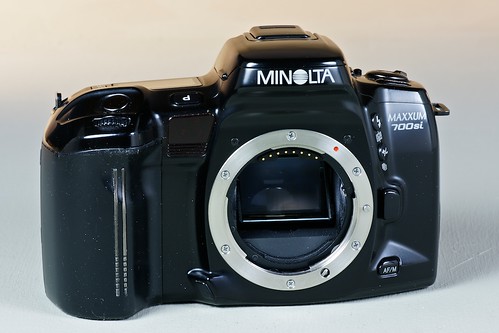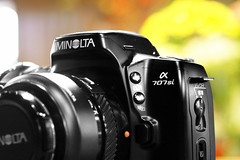Minolta Dynax 700si

|
| Maxxum 700si image by Mikel Adell (Image rights) |
The Minolta Dynax 700si is an autofocus 35mm film SLR camera manufactured by Minolta in 1993. It is also known as the Maxxum 700si in North America and as the α-707si (Alpha 707si) in Japan. The Japanese model is more advanced with panorama and quartz date standard.
It uses the Minolta A type bayonet mount for lenses. It can still uses the expandable chip card system found on previous cameras like 9xi, but a majority of the features are already built into the camera so a majority of the cards dont serve a good purpose. If features the Eye-start system which can be activated with a switch toggle on the bottom back of the camera. This allows the camera to set focus and exposure automatically without having to do the usual half press of the shutter button. It does this by using sensors in the hand grip and viewfinder areas.
The shutter is electronically controlled vertical focal plane shutter with speeds of 8 sec to 1/8000 sec. Flash synchronisation is at 1/200 sec or slower.
The autofocus is based on a TTL type phase detection using four CCD sensors with a sensitivity of -1 to 19 EV at (ISO100). It also has an AF illumination with a range up to 7m to assist in darker situations. An AF button is on the back and easily accessible with the right hand thumb. Press and hold the AF button and rotate the front knob to change the selective focus. There are two focus release modes. Focus priority mode, which can only trip the shutter when in perfect autofocus and release priority mode when absolute autofocus is not necessary. The AF/M button is below the lens release button, it allows you to quickly go into manual focus mode.
The metering modes available include a 14 segment honeycomb pattern and center-weighted averaging both with a sensitivity of 0 to 20 EV. Spot metering is also available with a range of 3 to 20 EV (f1.4 lens). Changing the metering mode requires one to open the card door, pressing the meter mode button and rotating either the front or back dial. The mode used will be displayed on the LCD and finder. A spot button is on the back, which allows you to lock spot meter reading. The meter uses two silicon based photo cells for the metering element with one dedicated to flash.
Exposure modes available include program AE, aperture priority AE, shutter priority AE, and manual exposure mode with bulb. In program exposure mode (P mode) you can also change the shutter (PS mode) or aperture settings (PA mode) by rotating the front dial for shutter and back dial for aperture. Exposure compensation can be enabled by holding a button on the side of the lens mount accessible with the left hand side. Rotate either the front or back dials to change settings ± 3 EV in ½ stops. Bracketing mode takes three shots, normal exposure, ½ over and ½ under. Press and hold the exposure compensation button and the shutter button simultaneously.
The film transport has a motor drive that automatically advances and rewinds. There is single and continuous drive modes. In single, after exposure the film advances one frame, in continuous mode, with the shutter release button held, the film is advanced up to 3 frames per sec. The film automatically rewinds when the roll is finished. There is a high speed loading and rewind mode which increases the speed but is a bit more audible. Press the drive mode button in the card door and slide the lock button to on.
The film can be DX coded or non-coded. ISO can be manually set on non-coded films. DX film setting are retained so non DX film will use the previous DX film settings. Automatic DX can also be overridden. To do so press the ISO button in the card door while rotating either the front or back knobs. The camera is powered by a 2CR5 lithium battery which is automatically checked on powerup.
Gallery
|
|

